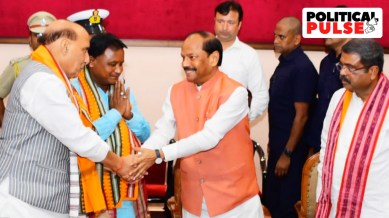Many strings attached: Messages in BJP picks for Odisha CM, Deputy CMs
For the BJP, the test has only begun in Odisha. And its first steps have been right, arguably.

As Odisha enters a new era of politics and governance after almost a quarter of a century under Naveen Patnaik, the BJP will look to meet the hopes and expectations of the people of a state that not only gave the party its first government in the East but also 20 MPs — four more than its largest NDA ally TDP — to the Narendra Modi government. And for the job, the party has picked Mohan Charan Majhi who took oath as Chief Minister at a grand event in Bhubaneswar on Wednesday.
The announcement of the new CM took one week to come after the results of the simultaneous elections in the state, possibly an indication of the careful deliberations that must have gone into picking a leader who would not only shoulder the expectations of the people but be an effective component in the BJP’s larger double-engine mechanism.
Majhi fits the bill, almost.
A tribal leader, he is a four-time MLA with a 10-year break in between which perhaps gave him invaluable experience at the grassroots. Although known to be vocal about people’s issues, which at times put him in a confrontation with district authorities comfortable in a supposedly invincible BJD regime, Majhi’s asset is his acceptance in a faction-ridden state BJP unit. That acceptance, of course, will have its share of tugs and pulls for him to handle as the CM.
But the biggest challenge will be to step into the boots of a leader who led the state for 24 years before him. And meeting the expectations of a generation that was born and grew old enough to vote under a single regime. Comparisons will be drawn with Naveen Patnaik, the former CM and statesman whose exit has drawn more emotions than his campaign. And opinions will be unleashed.
For a state that once figured more in poverty tales than those of its rich history, Odisha has come a long way in the past two decades. Today, it is getting into the habit of aspiring and achieving.
For the BJP, the test has only begun. The first moves have been right, arguably. At 52, the CM is young enough to bring energy, old enough to be seen as mature, considering his grassroots experience starting from his sarpanch days. He represents Keonjhar, a seat in the mineral-rich North Odisha, close to Jharkhand, that never before got a leader at the top. His elevation may be a return gift to a region that was once a BJP stronghold before the BJD moved in. Majhi as the CM also suits the BJP’s outreach to the tribal community, which forms more than 20% of the state’s population. It adds to the party’s narrative: President Droupadi Murmu from Mayurbhanj first, now Majhi from neighbouring Keonjhar. Both from the Santhal community, both relatively lesser known to the nation until the springboard arrived.
For the BJP, including a leader from the western region in a top position was almost a compulsion, considering the loyal vote bank that has paid rich dividends over the years. Incidentally, a senior party leader from the region, former MP Suresh Pujari who won the recent Assembly election, was considered a front-runner for the CM’s post until Majhi’s name was announced.
West Odisha, bordering Chhattisgarh, has over the past decades become a BJP fortress, more as a reaction to the dominance of the coastal region at power centre Bhubaneswar. A distinct dialect, distance from the state secretariat and years of neglect, largely because of power tussles among the coastal leaders often led to extreme feelings — from plain indifference to demands for a separate Kosal state.
In recent years, the region, which increasingly assumed significance as the BJP consolidated its presence, got widely publicised attention from the government — both at the state as well as the Centre, followed by development projects. The big test came in the Lok Sabha election when Union Minister Dharmendra Pradhan, widely considered as Odisha’s voice in Delhi, opted to contest from Sambalpur, the most prominent centre of the western region. Sambalpur obliged, choosing him over Pranab Prakash Das, the BJD’s organisation secretary whose candidature made it a prestige battle for both parties.
The selection of Singh Deo comes with its set of challenges unique to the region. Apart from bridging the gap, he will be expected to juggle between the roles of a champion for the Sambalpuri cause and that of a moderator in the big picture.
Incidentally, Defence Minister Rajnath Singh, who was the central observer along with Union Minister Bhupender Yadav at the BJP Legislature Party meeting that selected the new CM on Tuesday, said it was Singh Deo who proposed Majhi’s name for the top post.
Last, but not least, is the selection of Parida, a first-time MLA from Nimapara in Puri district, as a Deputy CM. By picking the 57-year-old leader, who has the experience of heading the party’s women’s wing in the state, the BJP has accomplished two tasks: giving representation to coastal Odisha and installing a woman leader in a senior position. The party perhaps also intended to send across a message to its cadres that loyalty and perseverance will be rewarded.
Coastal Odisha is significant in the state’s political history as it has decided the CM for decades, barring smaller stints for leaders airdropped by Delhi in the past. Unlike other regions of the state, it had been fickle in picking and dropping leaders in the pre-BJD era, and is used to getting its way. For this long strip of the state — stretching from Balasore, Kendrapara, and Jagatsinghpur to Ganjam, the home district of Naveen Patnaik, reciprocity is primary until it is convinced of loyalty.
And it will keep the new government busy.